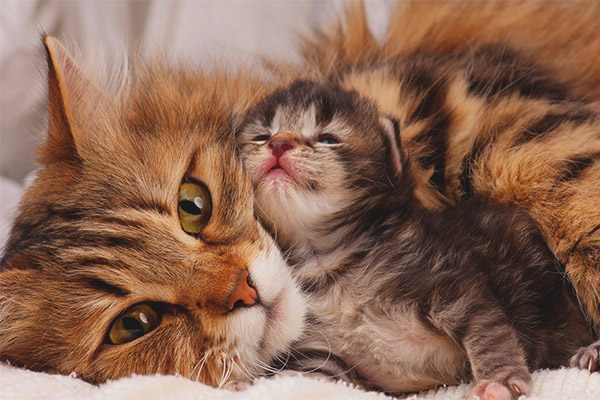The content of the article
Connoisseurs and cat lovers rarely keep only one fluffy friend at home - often in the future they take a small kitten into the house so that the mustache of the pet is not bored and lonely. And at the same time, there is often a problem, how to make friends between a long-living cat in the house, which considers itself the rightful owner of the house, and the young new-comer cat.
Each owner has a desire, so that the young and experienced cats become friends, live in complete agreement and understanding. This is easily achieved by following some rules and applying small tricks.
How to make a kitten and a cat make friends?
First you need to get used to the idea that the adult cat living in the house will not immediately get used to the new little neighbor. It rarely happens that they make friends right away, but if the tailed mistress of the house has a calm character and is distinguished by friendliness, then he will quickly accept a new guest.As a rule, cats are neutral to small kittens, while others show aggression - they hiss, make threatening attacks, attack, and sometimes even start a fight.
If the owner takes the second animal into the house thoughtfully, then it is better to take the baby no older than three months. Then the cat may even wake up the mother's instincts, and the little lump adapts easily. But if the appearance of a new family member was spontaneous (donated, picked up on the street, etc.), then you will have to apply some methods to make the beasts become friends.
So, expert advice:
- At the first meeting and acquaintance must be present owner. Leaving animals alone with each other without supervision is impossible.
- The little pet still does not know that the first acquaintance is hard, but an adult cat before this procedure needs a little encouragement - to stroke, to give something tasty.
- If there is no visible aggression on the part of the old-timer towards the new neighbor, then you should not rush things by pushing the animals to each other forcibly. We must look closely at their behavior and not expect that the cat will immediately accept the new neighbor with open arms.They can get used to one another for a long time - many days and months. And while this addiction is going on, the territory, as well as the resources (tray, dishes and so on), should be divided. To settle a little stranger away from the favorite places of the fluffy old-timers, otherwise the kid will have to be tight. A section of resources will help prevent conflicts in the early days and the emergence of mutual stressful situations.
- You can cheat a little and make an attempt to deceive an adult cat. Take her favorite treat (food sauce, let's say) and anoint the forehead of a new pet. This will discourage the unfamiliar smell and interest the adult fluffy mistress of the house with the familiar pleasant scent.
How to introduce a kitten with a cat
If a male cat already lives in the house, then the appearance of a small relative can turn into a big problem. The fact is that male cats have no maternal instinct, and to other cats (even small ones) that encroach on their territory, they have only hostile feelings.
Owners and owners need to be patient, not to swear at animals, not to be left in the same room in the hope that they will become friends, and not to use force.Otherwise, you can get only two cats in a state of stress and forever say goodbye to the dream of their friendship. If you take into account the features of both animals, then there will be more chances that acquaintance will be easier. One of the features - cats in every way defend their territory, and the appearance of a stranger is perceived as an encroachment. Therefore, it is better to acquaint them with each other gradually. Here are some of the nuances of this process:
- Having brought a small kitten home, it is better to settle it for several days (about a week) separately from adults in another room. For the first couple of days, let her stay in the box, and when she gets used to it, let her run. During this time, you should not bring a young pet and an old-timed cat together - let them get used to the smells of other animals. And for this period the kitten will get used to and adapt in the new house.
- When the baby leaves his box, where he lived for the first time, it must be taken to the place where the owner cat lives. It makes sense to change cats litter, and if possible - the cats themselves. Let the old-timers and the newcomer study each other's smells and get used to them. And after 5-7 days, bring their nose to the nose and introduce.By the way, the method is suitable if you have problems in getting acquainted with a cat.
- Acquaintance should occur exclusively under the supervision of the owner. If one of the parties began to show even the slightest signs of aggression, then you should immediately interrupt the meeting and breed both animals. And in any case, you can not blame the aggressive cat. Do not be ashamed of him, and especially punish physically. Cats are created by nature as loners, and he does such things instinctively, and not because there are some other reasons. The next attempt to bring together two cats should be repeated no earlier than the next day.
- If during contact there is no aggression, then you should carefully watch the cats. Do not forget about the separate resources. Both pets — the little novice and the big old-timer — should have personalized trays, separate bowls, bedding, etc. And you need to arrange them so that along the road to them the cat's paths do not intersect. Then there will be no competition and struggle for the possession of the necessary thing and there will be no infringement of rights.
- When both cats become friends, you can begin to bring their bowls together with food, gradually moving them closer and closer.In the same way it is worth bringing the trays together until they are in the same room. The owner in communicating with the kitten should observe the principle of equality. That is, to give him as much attention as an adult pet. Otherwise, there will be jealousy and hostile feelings towards the new resident. It should also be played evenly with both cats.
And if the owner believes that he has tried all the methods and all sorts of ways, but the problem remains, then the only option left is to give the kitten to other owners.
If animals live in the house, then it is full of joy, positive emotions and happiness. In order for their joint life to proceed peacefully and in harmony, it is necessary to work hard, showing patience and attention. Having shown these emotions to the maximum, you can conquer nature and make an adult cat to be friends with a little naughty kitten. And then the good mood in the house will be more exactly twice!
Video: acquaintance of a kitten with an adult cat












To send